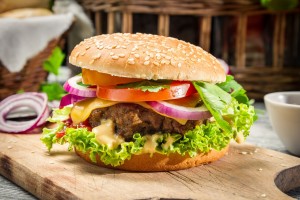 If you’re a carnivore who’d like to take a bite of physical, tangible heaven, you need to build a better hamburger. I’m not talking about a monstrosity covered in half a pound of bacon, 12 slices of cheese, grilled onions, mushrooms and condiments leaking out from every side. While I agree a “Frankenstein” burger with a ton of ingredients can be mighty tasty — and kill a wicked protein craving at the same time — the true star of the show gets buried beneath a cornucopia of contending flavors.
If you’re a carnivore who’d like to take a bite of physical, tangible heaven, you need to build a better hamburger. I’m not talking about a monstrosity covered in half a pound of bacon, 12 slices of cheese, grilled onions, mushrooms and condiments leaking out from every side. While I agree a “Frankenstein” burger with a ton of ingredients can be mighty tasty — and kill a wicked protein craving at the same time — the true star of the show gets buried beneath a cornucopia of contending flavors.
Let’s take our quest for a better burger down a notch or two. It’s time to step back from the overcomplicated, and focus on the two most important ingredients any hamburger needs: the beef itself, and the bun.
Building an incredible burger is not as hard as you think. The simple mantra you need to repeat to yourself is “quality over quantity.” Sure, you’re an American, and you’re hungry, and your burger needs to be big, but the size of the patty you get when you eat out — unless you know where to go and are willing to spend some dough — often comes at the price of quality.
The average American burger tends to come from cattle raised on industrial farms en masse, and fed all kinds of drugs and hormones in order to keep the livestock alive … long enough. While that might be necessary for a nation that eats as much meat as ours, there’s no reason (outside of budget) for a hamburger connoisseur to “follow the herd.”
Grass fed beef tastes like real beef. If you haven’t tried it, you need to. The flavor just might surprise you. Find a local farmer, grassfed certified if you can, who raises cattle naturally, or buy some imported Argentinian beef.
Now, if you want a better burger, I’d advise going with grass fed, but that can be a little gamey at first for folks raised on the products and prices of intensive animal farming. If you’re going to stick with store-bought beef, don’t buy ground hamburger. Get you hands on some chuck, or if you have the cash, ground sirloin. If you’re able to grind the chuck (you want about 20% fat) yourself, that’s even better. Freshly ground meat is healthier, and tastier than the stuff that’s been sitting around for a while.
Season the meat with salt and ground pepper before you make your patties. Build the patty sizes to your own personal tastes. You’ll find a variety of opinions about how to cook or grill your hamburgers. Methods tend to vary according to size. The important thing to remember is to start with beautiful beef. Experiment a little and find flavors that are best for you.
As far as buns go, store-bought bread comes in a variety of forms, from flat, stale and starchy, to soft and full. Arnold, Martin’s and Sunbeam are good picks for packaged buns. For those of you who really want great bread (and you should), nothing beats a freshly baked bun (no jokes, please). If your local bakery doesn’t have any available, you can make them at home.
Add a few toppings to your burger, like garden fresh onions and tomatoes, or some melted Roquefort cheese, if you’d like. Just remember that no matter how you choose to augment your chuck or sirloin, now that you’ve invested in superior ingredients, you don’t want to drown out the perfect combination of gorgeous beef and fresh bread with a ton of other distracting flavors.
Of course, if you do want to get fancy on occasion, and experiment with lamb, tuna, mustard and thick bacon, there’s no shortage of burger recipes out there for you to try out — just remember to adhere to quality ingredients when it comes to the basics.

























